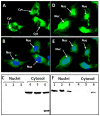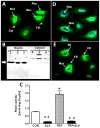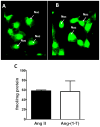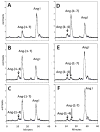Nuclear expression of renin-angiotensin system components in NRK-52E renal epithelial cells
- PMID: 24961503
- PMCID: PMC4276551
- DOI: 10.1177/1470320313515039
Nuclear expression of renin-angiotensin system components in NRK-52E renal epithelial cells
Abstract
Introduction: Isolated nuclei of sheep proximal tubules express angiotensin (Ang) receptors as well as angiotensinogen (AGT) and renin. The present study characterized the NRK-52E tubular epithelial cell line for the intracellular expression of renin-angiotensin system (RAS) components.
Methods: RAS components were visualized by immunofluorescent staining in intact cells and protein expression in isolated nuclei.
Results: An antibody to the angiotensin I (Ang I) sequence of AGT (AI-AGT) revealed only cytosolic staining, while an antibody to an internal sequence of AGT (Int-AGT) revealed primarily nuclear staining. Immunoblots of nuclear and cytosolic fractions confirmed the differential cell staining of AGT. Immunostaining for renin was present on nuclei of intact cells. Nuclear renin activity averaged 0.77±0.05 nmol/mg protein/h that was reduced by aliskiren (0.13±0.01 nmol/mg/h, n=3, p<0.01); trypsin activation increased activity three-fold. Peptide staining localized angiotensin II (Ang II) and Ang-(1-7) to the nucleus and peptide content averaged 59±2 and 57±22 fmol/mg (n=4), respectively. Peptide metabolism in isolated nuclei revealed the processing of Ang I to Ang-(1-7) by thimet oligopeptidase.
Conclusion: We conclude that the NRK-52E cells express an intracellular RAS localized to the nucleus and may be an appropriate cell model to elucidate the functional relevance of this system.
Keywords: NRK-52E; angiotensin; angiotensinogen; renin; thimet oligopeptidase.
© The Author(s) 2014.
Conflict of interest statement
None declared
Figures








Similar articles
-
Evidence for a mitochondrial angiotensin-(1-7) system in the kidney.Am J Physiol Renal Physiol. 2016 Apr 1;310(7):F637-F645. doi: 10.1152/ajprenal.00479.2015. Epub 2015 Dec 23. Am J Physiol Renal Physiol. 2016. PMID: 26697984 Free PMC article.
-
Angiotensin II mediates epithelial-to-mesenchymal transformation in tubular cells by ANG 1-7/MAS-1-dependent pathways.Am J Physiol Renal Physiol. 2010 Sep;299(3):F585-93. doi: 10.1152/ajprenal.00538.2009. Epub 2010 Jun 16. Am J Physiol Renal Physiol. 2010. PMID: 20554647
-
Nuclear angiotensin-(1-7) receptor is functionally coupled to the formation of nitric oxide.Am J Physiol Renal Physiol. 2010 Nov;299(5):F983-90. doi: 10.1152/ajprenal.00371.2010. Epub 2010 Sep 1. Am J Physiol Renal Physiol. 2010. PMID: 20810609 Free PMC article.
-
Recent Updates on the Proximal Tubule Renin-Angiotensin System in Angiotensin II-Dependent Hypertension.Curr Hypertens Rep. 2016 Aug;18(8):63. doi: 10.1007/s11906-016-0668-z. Curr Hypertens Rep. 2016. PMID: 27372447 Free PMC article. Review.
-
Evolving concepts on regulation and function of renin in distal nephron.Pflugers Arch. 2013 Jan;465(1):121-32. doi: 10.1007/s00424-012-1151-6. Epub 2012 Sep 19. Pflugers Arch. 2013. PMID: 22990760 Free PMC article. Review.
Cited by
-
Intracellular angiotensin (1-7) increases the inward calcium current in cardiomyocytes. On the role of PKA activation.Mol Cell Biochem. 2015 Sep;407(1-2):9-16. doi: 10.1007/s11010-015-2449-4. Epub 2015 May 16. Mol Cell Biochem. 2015. PMID: 25981535
-
Update on the Angiotensin converting enzyme 2-Angiotensin (1-7)-MAS receptor axis: fetal programing, sex differences, and intracellular pathways.Front Endocrinol (Lausanne). 2014 Jan 9;4:201. doi: 10.3389/fendo.2013.00201. Front Endocrinol (Lausanne). 2014. PMID: 24409169 Free PMC article. Review.
-
Angiotensin-(1-7) abolishes AGE-induced cellular hypertrophy and myofibroblast transformation via inhibition of ERK1/2.Cell Signal. 2014 Dec;26(12):3027-35. doi: 10.1016/j.cellsig.2014.09.010. Epub 2014 Sep 19. Cell Signal. 2014. PMID: 25246357 Free PMC article.
-
Evidence that angiotensin II does not directly stimulate the MD2-TLR4 innate inflammatory pathway.Peptides. 2021 Feb;136:170436. doi: 10.1016/j.peptides.2020.170436. Epub 2020 Nov 9. Peptides. 2021. PMID: 33181267 Free PMC article.
-
Angiotensin Receptors Heterodimerization and Trafficking: How Much Do They Influence Their Biological Function?Front Pharmacol. 2020 Aug 3;11:1179. doi: 10.3389/fphar.2020.01179. eCollection 2020. Front Pharmacol. 2020. PMID: 32848782 Free PMC article. Review.
References
-
- Kobori H, Nangaku M, Navar LG, Nishiyama A. The intrarenal renin-angiotensin system: from physiology to the pathobiology of hypertension and kidney disease. Pharmacol Rev. 2007;59(3):251–87. - PubMed
-
- Paul M, Mehr AP, Kreutz R. Physiology of local renin-angiotensin systems. Physiol Rev. 2006;86:747–803. - PubMed
-
- Velez JC. The importance of the intrarenal renin-angiotensin system. Nat Clin Pract Nephrol. 2009;5(2):89–100. - PubMed
-
- Singh VP, Baker KM, Kumar R. Activation of the intracellular renin-angiotensin system in cardiac fibroblasts by high glucose: role in extracellular matrix production. Am J Physiol Heart Circ Physiol. 2008;294(4):H1675–1684. - PubMed
-
- Singh VP, Le B, Bhat VB, Baker KM, Kumar R. High-glucose-induced regulation of intracellular ANG II synthesis and nuclear redistribution in cardiac myocytes. Am J Physiol Heart Circ Physiol. 2007;293(2):H939–H948. - PubMed
Publication types
MeSH terms
Substances
Grants and funding
LinkOut - more resources
Full Text Sources
Other Literature Sources
Miscellaneous

